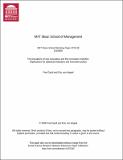The prevalence of user innovation and free innovation transfers: Implications for statistical indicators and innovation policy
Author(s)
Gault, Fred; von Hippel, Eric A.
DownloadFred and Eric 2009 2-2-09 FDG.pdf (246.0Kb)
Metadata
Show full item recordAbstract
Statistical indicators have not kept pace with innovation research. Today, it is well
understood that many industrial and consumer products are developed by users, and that
many innovations developed at private cost are freely shared. New statistical indicators
will empower policymakers to take advantage of the latest research findings in their
innovation policymaking, and will enable them to benefit from improved measurement of
resulting policy impacts.
In this paper, we report upon a pilot project in which a novel set of statistical
indicators were deployed in a 2007 survey of 1,219 Canadian manufacturing plants. The
plants all developed or modified “advanced” process technologies for in-house use.
Responses to the survey showed that data on both user innovation and the transfers of
these innovations could be reliably collected, and that novel findings important to
policymaking would result. One such finding: About 20% of the user-innovators
surveyed reported transferring their innovations to other users and/or equipment suppliers
– and the majority of these at least sometimes did so at no charge to recipients. Since
cost-free sharing of innovations is understood to result in greater social welfare than
licensing for a fee, innovation rates being equal, this finding has important public policy
implications. Current government innovation policies tend to favor and even to subsidize
the obtaining of intellectual property rights as a means of encouraging innovation. If a
significant fraction of user-innovators in the economy are already freely revealing their
innovations - despite the availability of intellectual property grants - perhaps intellectual
property rights policies should be reexamined.
We propose that improved versions of the novel statistical indicators piloted here
should be integrated into official statistics so that user innovation, and related matters such
as voluntary spillovers of innovation-related information, can be better monitored, better
understood, and better managed.
Date issued
2009-02-03Publisher
Cambridge, MA; Alfred P. Sloan School of Managememnt, Massachusetts Institute of Management
Series/Report no.
MIT Sloan School of Management Working Paper;4722-09
Keywords
user innovation